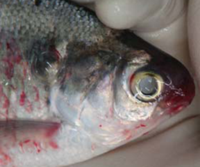
The invasive cestode parasite Ligula from salmonids and bullies on the South Island, New Zealand
Sign Up to like & getrecommendations! Published in 2017 at "Parasitology Research"
DOI: 10.1007/s00436-017-5684-7
Abstract: Freshwater ecosystems are often impacted by biological invasions, including the introduction of exotic parasites capable of infecting native species. Here, we report the occurrence of the introduced tapeworm Ligula sp. from common bully, Gobiomorphus cotidianus,… read more here.
Keywords: new zealand; ligula; south island; island new ... See more keywords

The Effects of Milkweed Induced Defense on Parasite Resistance in Monarch Butterflies, Danaus plexippus
Sign Up to like & getrecommendations! Published in 2018 at "Journal of Chemical Ecology"
DOI: 10.1007/s10886-018-1007-4
Abstract: Many plants express induced defenses against herbivores through increasing the production of toxic secondary chemicals following damage. Phytochemical induction can directly or indirectly affect other organisms within the community. In tri-trophic systems, increased concentrations of… read more here.
Keywords: effects milkweed; monarch; danaus plexippus; resistance ... See more keywords

Cloned and outbred Atlantic salmon display equal parasite dispersion when infected with the salmon louse
Sign Up to like & getrecommendations! Published in 2017 at "Aquaculture"
DOI: 10.1016/j.aquaculture.2017.08.008
Abstract: Abstract The salmon louse is an ectoparasitic copepod that infects salmonids in the marine environment. This parasite causes a major economic and biological challenge to the Atlantic salmon farming industry, and efforts to increase the… read more here.
Keywords: salmon; salmon louse; genetic variation; parasite ... See more keywords

Nosema neumanni n. sp. (Microsporidia, Nosematidae), a new microsporidian parasite of honeybees, Apis mellifera in Uganda.
Sign Up to like & getrecommendations! Published in 2017 at "European journal of protistology"
DOI: 10.1016/j.ejop.2017.07.002
Abstract: The microsporidium Nosema neumanni n. sp., a new parasite of the honeybee Apis mellifera is described based on its ultra-structural and molecular characteristics. Structures resembling microsporidian spores were found by microscopic examination of honeybees from… read more here.
Keywords: parasite; neumanni microsporidia; nosema neumanni; apis mellifera ... See more keywords

Evidence for the decline and possible extinction of a marine parasite species caused by intensive fishing
Sign Up to like & getrecommendations! Published in 2018 at "Fisheries Research"
DOI: 10.1016/j.fishres.2017.10.014
Abstract: Abstract The first good evidence of the role of intensive commercial fishing in the decline and possible extinction of a marine parasite is presented. The larva of Stichocotyle nephropis Cunningham, 1887 (Aspidogastrea: Digenea) was described… read more here.
Keywords: marine parasite; extinction marine; evidence; possible extinction ... See more keywords

Unraveling the microbiota of the fish parasite Pseudoterranova decipiens in codfish (Gadus morhua) reveals a fish-related bacterial community.
Sign Up to like & getrecommendations! Published in 2022 at "International journal of food microbiology"
DOI: 10.1016/j.ijfoodmicro.2022.109591
Abstract: Anisakidae, mainly represented by the species Anisakis simplex and Pseudoterranova decipiens, are one of the most commonly zoonotic nematodes present in marine fish species. Apart from public health risks directly linked to the parasite itself,… read more here.
Keywords: bacterial community; pseudoterranova decipiens; parasite; unraveling microbiota ... See more keywords

A host-independent role for Fasciola hepatica transforming growth factor-like molecule in parasite development.
Sign Up to like & getrecommendations! Published in 2021 at "International journal for parasitology"
DOI: 10.1016/j.ijpara.2020.11.005
Abstract: The trematode parasite Fasciola hepatica causes chronic infection in hosts, enabled by an immunosuppressed environment. Both host and parasite factors are known to contribute to this suggesting that avoidance of immunopathology is beneficial to both… read more here.
Keywords: transforming growth; fasciola hepatica; host; growth ... See more keywords

Correlated evolution of fish host length and parasite spore size: a tale from myxosporeans inhabiting elasmobranchs.
Sign Up to like & getrecommendations! Published in 2021 at "International journal for parasitology"
DOI: 10.1016/j.ijpara.2021.05.008
Abstract: Myxozoa represent a diverse group of microscopic cnidarian endoparasites alternating between invertebrate and vertebrate hosts. Of the approximately 2,600 species described predominantly from teleost fish, only 1.8% have been reported from cartilaginous fishes (Elasmobranchii). As… read more here.
Keywords: evolution; spore size; size; host ... See more keywords

Phosphorylation of Eukaryotic Initiation Factor 2-α in Response to Endoplasmic Reticulum and Nitrosative Stress in the human protozoan parasite, Entamoeba histolytica.
Sign Up to like & getrecommendations! Published in 2019 at "Molecular and biochemical parasitology"
DOI: 10.1016/j.molbiopara.2019.111223
Abstract: Entamoeba histolytica is an intestinal parasite infecting over 50 million people worldwide and is the causative agent of amebic dysentery and amoebic liver abscess. In the human host, E. histolytica experiences stress brought on by… read more here.
Keywords: response; stress; nitrosative stress; phosphorylation ... See more keywords

A lysosomal hydrolase receptor, CPBF2, is associated motility and invasion of the enteric protozoan parasite Entamoeba histolytica.
Sign Up to like & getrecommendations! Published in 2020 at "Molecular and biochemical parasitology"
DOI: 10.1016/j.molbiopara.2020.111299
Abstract: Proper targeting and secretion of lysosomal hydrolases are regulated by transporting receptors. Entamoeba histolytica, the enteric protozoan parasite responsible for human amebiasis, has a unique family of lysosomal hydrolase receptors, cysteine protease binding protein family,… read more here.
Keywords: invasion; hydrolase; motility; entamoeba histolytica ... See more keywords

Molecular identification of Neoechinorhynchus rutili parasite diagnosed in some fish species caught in Menzelet dam lake in Kahramanmaras province (Turkey)
Sign Up to like & getrecommendations! Published in 2020 at "Saudi Journal of Biological Sciences"
DOI: 10.1016/j.sjbs.2020.04.047
Abstract: This study details the molecular identification of the parasite Neoechinorhynchus rutili diagnosed in fish (Capoeta barroisi, Cyprinus carpio, Barbus rajanorum) caught in Menzelet Dam Lake in Kahramanmaras Province, Turkey. Parasite samples were obtained from the… read more here.
Keywords: rutili; identification; kahramanmaras province; parasite ... See more keywords